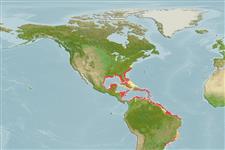Common names from other countries
Environment: milieu / climate zone / depth range / distribution range
Écologie
marin récifal; profondeur 1 - 54 m (Ref. 9710). Subtropical; 38°N - 27°S, 99°W - 35°W (Ref. 189)
Western Atlantic: New York south to Miami (rare on the Gulf coast of Florida), Bermuda, Antilles, Trinidad and south to Brazil; also Venezuela to Panama, Yucatan and to northern Gulf of Mexico.
Taille / Poids / Âge
Maturity: Lm ? range ? - ? cm
Max length : 12.0 cm TL mâle / non sexé; (Ref. 5217); common length : 9.0 cm TL mâle / non sexé; (Ref. 5217)
Épines dorsales (Total): 0; Rayons mous dorsaux (Total): 14-16; Épines anales 0; Rayons mous anaux: 21 - 23. Snout long and pointed, only slightly less than eye diameter; maxilla long, tip pointed, reaching almost to gill opening; gill cover canals of panamensis-type; pseudobranch longer than eye diameter, with 30 or more filaments, extending onto inner face of operculum. Pectoral fin with first ray not filamentous. Silver stripe along flank about equal to eye diameter, with dark line above it (Ref. 189). Melanophores evenly distributed, usually not forming a middorsal stripe. Iridescent golden spot on top of head (Ref. 7251).
A schooling species occurring in coastal waters. Feeds on plankton.
Life cycle and mating behavior
Maturité | Reproduction | Frai | Œufs | Fécondité | Larves
Spawn in school (Ref. 205).
Whitehead, P.J.P., G.J. Nelson and T. Wongratana, 1988. FAO Species Catalogue. Vol. 7. Clupeoid fishes of the world (Suborder Clupeoidei). An annotated and illustrated catalogue of the herrings, sardines, pilchards, sprats, shads, anchovies and wolf-herrings. FAO Fish. Synop. 125(7/2):305-579. Rome: FAO. (Ref. 189)
Statut dans la liste rouge de l'IUCN (Ref. 130435)
CITES (Ref. 128078)
Not Evaluated
Menace pour l'homme
Harmless
Utilisations par l'homme
Pêcheries: pêcheries vivrières; appât: usually
Plus d'informations
RéférencesAquacultureProfil d'aquacultureSouchesGénétiqueElectrophoresesHéritabilitéPathologiesTraitementMass conversion
CollaborateursImagesStamps, Coins Misc.SonsCiguateraVitesseType de nageSurface branchialeOtolithesCerveauxVision
Outils
Articles particuliers
Télécharger en XML
Sources Internet
Estimates based on models
Preferred temperature (Ref.
115969): 22.9 - 28, mean 24.9 (based on 414 cells).
Phylogenetic diversity index (Ref.
82804): PD
50 = 0.5000 [Uniqueness, from 0.5 = low to 2.0 = high].
Bayesian length-weight: a=0.00490 (0.00309 - 0.00776), b=3.13 (3.00 - 3.26), in cm Total Length, based on LWR estimates for this species & Genus-body shape (Ref.
93245).
Niveau trophique (Ref.
69278): 3.4 ±0.45 se; based on food items.
Résilience (Ref.
120179): Haut, temps minimum de doublement de population inférieur à 15 mois (Preliminary K or Fecundity.).
Fishing Vulnerability (Ref.
59153): Low vulnerability (10 of 100).
